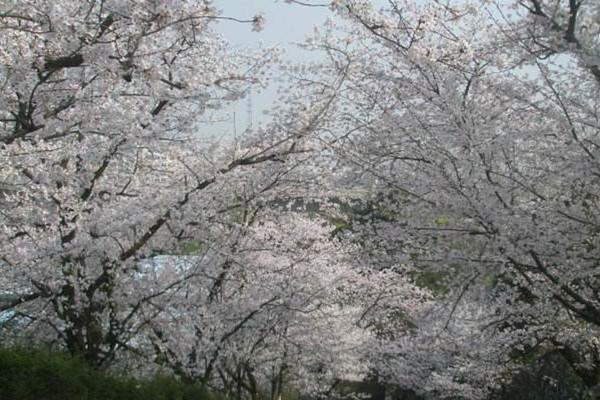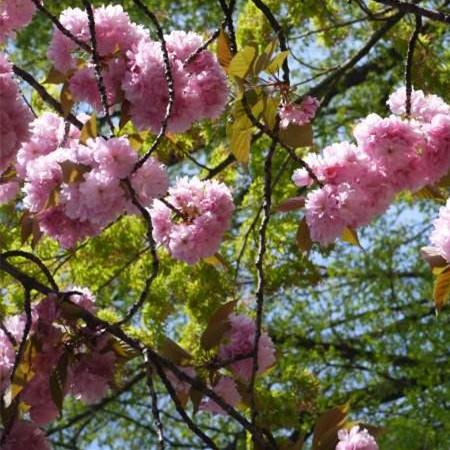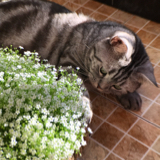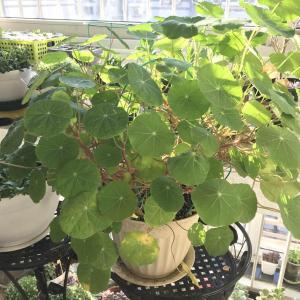文章
Miss Chen
2018年02月13日

Description: This perennial plant is about 4-10' tall and remains unbranched, except for the panicle of flowering stems near the apex. The central stem is thick, hairless, and four-sided. The large opposite leaves are up to 8" long and 5" across, which join together around the central stem to form a cup that can hold water, hence the name of the plant. These leaves are broadly lanceolate to cordate, coarsely toothed, and have a rough, sandpapery texture. The yellow composite flowers bloom during early to mid-summer for about 1-1½ months. Each sunflower-like composite flower is about 3-4" across, consisting of numerous yellow disk florets that are surrounded by 18-40 yellow or pale yellow ray florets. The infertile disk florets protrude somewhat from the center and are rather conspicuous, while the ray florets are fertile. The latter produce thin achenes, each with a well-developed marginal wing, which are dispersed to some extent by the wind. The root system consists of a central taproot, and abundant shallow rhizomes that help to spread the plant vegetatively, often forming substantial colonies.

Cultivation: The preference is full or partial sun, and moist loamy soil. This plant may drop some of its lower leaves in response to a drought. Sometimes, the leaves and buds of distressed plants turn brown, growth becomes stunted, and blossums abort in response to disease or drought. Another problem is that Cup Plant may topple over during a rainstorm with strong winds, particularly while it is blooming, or situated on a slope.
Range & Habitat: The native Cup Plant occurs throughout Illinois, except for a few southern counties (see Distribution Map). It is fairly common. Typical habitats include moist black soil prairies, moist meadows near rivers, low-lying woodland edges and thickets, fens and seeps, lake borders, fence rows, and along ditches near railroads.

Faunal Associations: Long-tongued bees, butterflies, and skippers are common visitors and the most important pollinators of the flowers. Some short-tongued bees, wasps, bee flies, and other kinds of flies also visit the flowers for pollen or nectar. The larvae of an Antistrophus sp. (Gall Wasp sp.) feed within the stems of this plant, and may attract the hyperparasitic wasp Eurytoma lutea. Various birds, especially goldfinches, are very fond of the seeds, and drink water from the cups formed by the leaves. Because of the tendency to form dense colonies, this plant provides good cover for birds, which often lurk among the leaves during the heat of the day, searching for insects or pausing to rest. Large herbivores, especially cattle, may eat the eat leaves of Cup Plant, especially those of immature plants.
Photographic Location: The photographs of the flowering plants and perfoliate leaves were taken at a small restored prairie in Urbana, Illinois, while the photograph of the flowerhead close-up was taken at Meadowbrook Park in Urbana, Illinois.
Comments: This is an imposing, but attractive plant when it is in bloom. Cup Plant is easy to distinguish from other Silphium spp., as well as various sunflowers, by the perfoliate leaves that can hold water, and the hairless four-angled stems.

Cultivation: The preference is full or partial sun, and moist loamy soil. This plant may drop some of its lower leaves in response to a drought. Sometimes, the leaves and buds of distressed plants turn brown, growth becomes stunted, and blossums abort in response to disease or drought. Another problem is that Cup Plant may topple over during a rainstorm with strong winds, particularly while it is blooming, or situated on a slope.
Range & Habitat: The native Cup Plant occurs throughout Illinois, except for a few southern counties (see Distribution Map). It is fairly common. Typical habitats include moist black soil prairies, moist meadows near rivers, low-lying woodland edges and thickets, fens and seeps, lake borders, fence rows, and along ditches near railroads.

Faunal Associations: Long-tongued bees, butterflies, and skippers are common visitors and the most important pollinators of the flowers. Some short-tongued bees, wasps, bee flies, and other kinds of flies also visit the flowers for pollen or nectar. The larvae of an Antistrophus sp. (Gall Wasp sp.) feed within the stems of this plant, and may attract the hyperparasitic wasp Eurytoma lutea. Various birds, especially goldfinches, are very fond of the seeds, and drink water from the cups formed by the leaves. Because of the tendency to form dense colonies, this plant provides good cover for birds, which often lurk among the leaves during the heat of the day, searching for insects or pausing to rest. Large herbivores, especially cattle, may eat the eat leaves of Cup Plant, especially those of immature plants.
Photographic Location: The photographs of the flowering plants and perfoliate leaves were taken at a small restored prairie in Urbana, Illinois, while the photograph of the flowerhead close-up was taken at Meadowbrook Park in Urbana, Illinois.
Comments: This is an imposing, but attractive plant when it is in bloom. Cup Plant is easy to distinguish from other Silphium spp., as well as various sunflowers, by the perfoliate leaves that can hold water, and the hairless four-angled stems.
0
0
文章
Miss Chen
2018年02月12日

Description: This perennial wildflower is woody at the base and only 4-10" tall. The lower stems have shredded bark that is grey-brown, while the upper stems are non-woody and light green to red. Most branching occurs toward the base of each plant; the stems have a tendency to sprawl across the ground as they become longer. Alternate trifoliate leaves develop primarily from the base of each stem. Individual leaflets are up to 1½" long and ½" across; the middle leaflet is usually longer than the 2 lateral leaflets. The shape of each leaflet is oblanceolate, terminating in a truncate tip with 3 large teeth. The leaflets are evergreen with a somewhat thick leathery texture; their upper surfaces are medium to dark green and shiny, while their lower surfaces are pale green and often slightly pubescent. During the winter, the leaflets often become tinted with red. Each trifoliate leaf has a long petiole up to 2" long; this petiole is light green to red and it has a pair of large linear-lanceolate stipules at its base. Some of the upper stems terminate in cymes or compound cymes of 1-12 flowers. Each flower is up to ½" across, consisting of 5 white petals, a light green calyx with 5 ovate teeth, a dense cluster of pistils, and 20-30 stamens. Adjacent to the calyx of the flower, there are 5 light green bracteoles (tiny bracts); these bracteoles are linear-oblong and shorter than the teeth of the calyx. The slender white styles of the pistils spread laterally from the center of the flower. The branches of each cyme are terete, light green, and often pubescent. At the base of each fork in the cyme, there is a pair of small lanceolate bracts.

The blooming period occurs during the summer and lasts about 2-3 months. At maturity, each flower produces a cluster of hairy brown achenes. The root system is woody and can produce vegetative offsets from underground runners. Older plants may produce a caudex.
Cultivation: The preference is plenty of sun, dry conditions, and well-drained soil that is rocky, gravelly, or sandy. This plant can adapt to a rock garden if it is sunny and well-drained. Because this is a boreal species, it dislikes excessive heat during the summer.
Range & Habitat: In Illinois, Three-Toothed Cinquefoil has been found only in Cook County (see Distribution Map), where it was probably native. Because this species has not been observed in any natural area of the state since 1895, it is probably extirpated within the state. The habitat of Three-Toothed Cinquefoil in Illinois was a gravel hill prairie. Outside of the state, it is found on treeless mountain tops and other upland rocky areas that are sunny; it also occurs along sandy banks. The range of this species extends from the upper Great Lakes to New England, and then northward to the Arctic Circle of Canada and Greenland. Small isolated populations still occur in the Appalachian Mountains as far south as northern Georgia.
Faunal Associations: Because this species is quite rare in Illinois and the surrounding area, information about floral-faunal relationships is unavailable. Like similar Potentilla spp. (Cinquefoil species), the flowers probably attract small bees and Syrphid flies.
Photographic Location: A rock garden at the Arboretum of the University of Illinois in Urbana, Illinois.
Comments: Another scientific name of this species is Potentilla tridentata. Three-Toothed Cinquefoil was reclassified into its own genus as a result of genetic analysis, which revealed that it was more closely related to another boreal species, Sibbaldia procumbens (Sibbaldia). The trifoliate leaves of this latter species are similar to those of Three-Toothed Cinquefoil, but the flowers of Sibbaldia are less showy because of the small size of the petals. Three-Toothed Cinquefoil differs from Potentilla spp. by the lateral styles of its flowers; it also differs from many of these species by its woody lower stems and evergreen leaves.

The blooming period occurs during the summer and lasts about 2-3 months. At maturity, each flower produces a cluster of hairy brown achenes. The root system is woody and can produce vegetative offsets from underground runners. Older plants may produce a caudex.
Cultivation: The preference is plenty of sun, dry conditions, and well-drained soil that is rocky, gravelly, or sandy. This plant can adapt to a rock garden if it is sunny and well-drained. Because this is a boreal species, it dislikes excessive heat during the summer.
Range & Habitat: In Illinois, Three-Toothed Cinquefoil has been found only in Cook County (see Distribution Map), where it was probably native. Because this species has not been observed in any natural area of the state since 1895, it is probably extirpated within the state. The habitat of Three-Toothed Cinquefoil in Illinois was a gravel hill prairie. Outside of the state, it is found on treeless mountain tops and other upland rocky areas that are sunny; it also occurs along sandy banks. The range of this species extends from the upper Great Lakes to New England, and then northward to the Arctic Circle of Canada and Greenland. Small isolated populations still occur in the Appalachian Mountains as far south as northern Georgia.
Faunal Associations: Because this species is quite rare in Illinois and the surrounding area, information about floral-faunal relationships is unavailable. Like similar Potentilla spp. (Cinquefoil species), the flowers probably attract small bees and Syrphid flies.
Photographic Location: A rock garden at the Arboretum of the University of Illinois in Urbana, Illinois.
Comments: Another scientific name of this species is Potentilla tridentata. Three-Toothed Cinquefoil was reclassified into its own genus as a result of genetic analysis, which revealed that it was more closely related to another boreal species, Sibbaldia procumbens (Sibbaldia). The trifoliate leaves of this latter species are similar to those of Three-Toothed Cinquefoil, but the flowers of Sibbaldia are less showy because of the small size of the petals. Three-Toothed Cinquefoil differs from Potentilla spp. by the lateral styles of its flowers; it also differs from many of these species by its woody lower stems and evergreen leaves.
0
0
文章
权问薇
2018年02月04日


1、及时的把它移栽室内
到了冬天以后,大家都知道,温度就会慢慢开始越来越低,所以这时候我们一定要将玉树及时的移到室内,并且还要把温度维持在7到10度,这样才不会把它冻伤了。
如果有哪一天,外面的天气非常暖和,阳光也很好,我们就可以在中午的时候,将它移动到室外,让它享受一下光照,这样可以让它的叶子进行一定的光合作用,以便于植株更好生长,之后等到夜晚的时候,再把它移回到房间里。

2、控制好盆土的干湿度
在冬天的时候,土壤的湿度也需要我们的关注,一般在这个时候尽量少浇一点水,让盆土稍微干燥一点,并经常用一些细喷雾往它的叶子上喷一喷,这样就可以很好的给它补水。所以一般情况下,是无需给它浇水的。
3、移到暖棚里保温
到了冬天的时候,有一些人会选择把它移到室内,但是有时候温度不好控制,所以有条件的,可以把它移到暖棚里面,这样保温效果更好。如果没有条件的,也不要怕,我们可以找一些薄膜给它罩起来,但是要注意里面的湿度,如果发现湿度太大的话,一定要及时的把薄膜揭开,让它通一下风,换下气,防止它叶子腐烂。

4、正确处理冻伤植株
在冬天的时候,有一些植株免不了会出现冻害,而我们就会以为它死掉了,然后就会将它们丢掉,其实这样是不对的。如果发现冻伤的植株,我们只需要将它冻死的叶子、枝条给清理掉,把主茎保存起来就好了,等到下年春天到来的时候,给它施加一定的肥料,它依旧可以很快的长出来新的枝叶,一般过上1到2年,就可以长成一棵新的玉树了。

0
0
文章
权问薇
2018年02月02日


一.播种
1在采收了樱桃之后,可以取出果核,然后用清水洗干净外面的果肉,放在比较阴凉的地方自然地晾干。播种之时可以直接把种子撒在盆里面,播了之后大概过10到30天它就会出芽。我们可以等到它长出来的小苗有5到10厘米高的时候,把它们移植到塑料盆里面。这种植物的种子非常容易出芽,但是它们出芽不太齐整而且有些植株生产的种子所含胚没哟足够的活力,出芽的几率要低于百分之三十。
2如果是采用播种的方式,那么就要注意不要让种子干燥,应该采下来之后就立刻播种,要不然就用湿的厚的泥沙堆积它们然后等到第二年才去播种。

二.扦插
1这种植物要进行扦插的话最好是选择在春天或者是夏天这两个生长的季节。首先选取一些半成熟的健康的枝条,大概直径要达到0.7到1.2厘米,而且每一段要有15到20厘米长,每一段要长有4到6片叶子。
2然后把它们插到河砂、泥炭土或者是蛭石混合起来的苗床上面,插的时候要注意保持泥土的湿润,并且还要给枝条遮阴。插好后大概经过1.5到2个月它就会长出根来,等到根部长得比较旺盛的时候再把它移植。

三.压条
这种方法要选择长了两年以上的枝条,然后在它下面靠近节的位置环绕着剥皮,然后把湿润的茸草放在一个透明的胶袋里面,再把枝条放进去,把伤口包起来,当它长出根部以后,就可以把压条的部分下面的都剪短,这样盆栽就会生长为新的植株。通常这种方法都是选择在春夏两个生长比较旺盛的季节进行,这样容易让它长出根部。

1
2
文章
Miss Chen
2018年02月01日

Description: This perennial plant is 2-5' tall and unbranched, except near the inflorescence. The central stem is covered with fine white hairs. The basal leaves are up to 10" long and 5" wide, while much smaller leaves alternate upward along the central stem. These leaves are light green and pubescent; their margins are smooth or slightly serrated. They are variably shaped, appearing lanceolate, oblanceolate, oblong, or oval, but always with blunt tips. Initially, the leaves have a soft floppy texture, but they become more stiff later in the year. The basal leaves often persist through the winter and are semi-evergreen. At the apex of the central stem is a corymb of small yellow flowers. This inflorescence is about 2-4" across, while each flower is ¼–½" across. The upper side stems also produce corymbs of these flowers, which are more or less all bunched together. There is a mild floral fragrance. The blooming period occurs from late summer to fall, and lasts about a month. The achenes have small tufts of white or light brown hair, and are distributed by the wind. This plant has deep fibrous roots, and it has a tendency to form offsets.
Cultivation: The preference is full sun and moist to slightly dry conditions. This plant is not particular about soil, which can consist of loam, clay-loam, or gravelly material. There is a tendency to flop over during bloom if it is spoiled by fertile soil or too much water. Powdery mildew sometimes attacks the leaves. Drought resistance is good; some of the lower leaves may wither away in response. This plant is easy to grow.
Range & Habitat: The native Stiff Goldenrod occurs in most counties of Illinois and is fairly common, but it is rare or absent in parts of southern Illinois (see Distribution Map). Habitats include moist to slightly dry black soil prairies, clay prairies, savannas, thickets, limestone glades, abandoned fields, roadsides, and open areas along railroads, particularly where prairie remnants occur.

Faunal Associations: The flowers attract many kinds of insects, including long-tongued bees, short-tongued bees, wasps, flies, butterflies, and beetles. Monarch butterflies are especially attracted to the flowers. The caterpillars of several species of moths feed on various parts of this and other goldenrods (see Moth Table). Other insects that feed on this plant are Disonycta latifrons (Flea Beetle sp.), Microrhapala vittata (Leafminer Beetle sp.), Hesperotattix viridii (Spur-Throated Grasshopper sp.), and Corythucha marmorata (Lace Bug sp.). The Greater Prairie Chicken and Eastern Goldfinch eat the seeds to a limited extent. Many mammalian herbivores eat this plant, particularly during the early stages of growth and development. This includes the White-Tailed Deer, Cottontail Rabbit, Muskrats, and livestock. The latter tend to leave this plant alone when there are other sources of food available.

Photographic Location: The photographs were taken at Meadowbrook Park in Urbana, Illinois, and the wildflower garden of the webmaster in the same city.
Comments: This is one of the more attractive goldenrods. It has a unique appearance and is easy to distinguish from other goldenrods: 1) the foliage is quite pubescent and light green, with a felty appearance; 2) the basal leaves are quite large, assuming that they haven't withered away; 3) the inflorescence consists of erect bunches of flowers; it does not radiate outward, nor form a narrow wand; 4) the individual flowers are slightly larger than those of other goldenrods. Along with a few other goldenrod species, such as Riddell's Goldenrod and Ohio Goldenrod, Stiff Goldenrod has been recently reassigned from the Solidago genus to the Oligoneuron genus. Formerly, it was referred to as Solidago rigida.
Cultivation: The preference is full sun and moist to slightly dry conditions. This plant is not particular about soil, which can consist of loam, clay-loam, or gravelly material. There is a tendency to flop over during bloom if it is spoiled by fertile soil or too much water. Powdery mildew sometimes attacks the leaves. Drought resistance is good; some of the lower leaves may wither away in response. This plant is easy to grow.
Range & Habitat: The native Stiff Goldenrod occurs in most counties of Illinois and is fairly common, but it is rare or absent in parts of southern Illinois (see Distribution Map). Habitats include moist to slightly dry black soil prairies, clay prairies, savannas, thickets, limestone glades, abandoned fields, roadsides, and open areas along railroads, particularly where prairie remnants occur.

Faunal Associations: The flowers attract many kinds of insects, including long-tongued bees, short-tongued bees, wasps, flies, butterflies, and beetles. Monarch butterflies are especially attracted to the flowers. The caterpillars of several species of moths feed on various parts of this and other goldenrods (see Moth Table). Other insects that feed on this plant are Disonycta latifrons (Flea Beetle sp.), Microrhapala vittata (Leafminer Beetle sp.), Hesperotattix viridii (Spur-Throated Grasshopper sp.), and Corythucha marmorata (Lace Bug sp.). The Greater Prairie Chicken and Eastern Goldfinch eat the seeds to a limited extent. Many mammalian herbivores eat this plant, particularly during the early stages of growth and development. This includes the White-Tailed Deer, Cottontail Rabbit, Muskrats, and livestock. The latter tend to leave this plant alone when there are other sources of food available.

Photographic Location: The photographs were taken at Meadowbrook Park in Urbana, Illinois, and the wildflower garden of the webmaster in the same city.
Comments: This is one of the more attractive goldenrods. It has a unique appearance and is easy to distinguish from other goldenrods: 1) the foliage is quite pubescent and light green, with a felty appearance; 2) the basal leaves are quite large, assuming that they haven't withered away; 3) the inflorescence consists of erect bunches of flowers; it does not radiate outward, nor form a narrow wand; 4) the individual flowers are slightly larger than those of other goldenrods. Along with a few other goldenrod species, such as Riddell's Goldenrod and Ohio Goldenrod, Stiff Goldenrod has been recently reassigned from the Solidago genus to the Oligoneuron genus. Formerly, it was referred to as Solidago rigida.
0
0
文章
Miss Chen
2018年01月30日

Description: This perennial plant consists of a loose rosette of basal leaves up to 10" across. Each basal leaf is about 4-6" long and ¼" across, although occasionally a larger size is achieved. The basal leaves are semi-erect, linear in shape, and light to medium green; their margins are finely crisped and often downy white. There is a prominent central vein along the length of each basal leaf. From the center of each rosette, there develops one or more leafless stalks about 6-8" tall. These stalks are light green and terete; sometimes they have shallow vertical grooves. Both the basal leaves and flowering stalks are glabrous to slightly pubescent; they contain a white milky latex. Each stalk terminates in a single flowerhead that is about 1-2" across when it is fully open.
Each flowerhead consists of numerous spreading ray florets and no disk florets. The overlapping petaloid rays of each flowerhead are yellow to golden yellow and linear-oblong in shape; their tips are truncated and 5-toothed. The floral bracts (phyllaries) surrounding the base of each flowerhead are arranged in a single overlapping series, where they are appressed together. These bracts are light green, lanceolate in shape, glabrous, and membranous along their margins. The blooming period occurs from mid- to late spring and lasts about a month. A single plant may produce several flowerheads in succession. The achenes are bullet-shaped with tufts of white hair at their apices. They are distributed by the wind. The root system consists of a stout taproot that is quite large for the size of the plant. This plant spreads by reseeding itself.

Cultivation: The preference is full sun and dry conditions. The soil should be gritty in texture and well-drained, otherwise crown rot may infect the taproot and the plant will die. Taller and more aggressive plant species should be prevented from overcrowding this plant, which normally grows on rocky hilltops and slopes where there is scant ground vegetation.
Range & Habitat: The native Prairie Dandelion is a rare plant that occurs in the northern half of Illinois, especially in the NW quarter of the state (see Distribution Map). It is state-listed as an endangered species. Some local populations that have been observed in the past are probably extirpated as a result of habitat destruction. Illinois lies at the eastern limit of its distribution; the Prairie Dandelion is more common in states further to the west. Habitats include dry upland areas of prairies, hill prairies, and rocky slopes. This conservative species does not normally occur in disturbed areas.

Faunal Associations: Little is known about the floral-faunal relationships of this rare plant. Various kinds of bees (especially bumblebees) are undoubtedly the most important pollinators of the flowers, where they seek nectar and pollen. Moure & Hurd (1987) list a Halictid bee, Halictus rubicundus, as a floral visitor. A polyphagous aphid, Abstrusomyzus phloxae, feeds on the closely related Mountain Dandelions (Agoseris spp.) and probably Prairie Dandelion as well. Rabbits may eat the foliage, although I have not observed this. Early pioneers ate the roots as a source of emergency food, even though they were undoubtedly bitter-tasting.
Photographic Location: The webmaster's wildflower garden in Urbana, Illinois.

Comments: This is one of many species in the Chicory tribe of the Aster family that have dandelion-like flowerheads and foliage with a milky latex. The most familiar member of this group is the introduced Taraxacum officinale (Dandelion), which is a common lawn weed. The Prairie Dandelion can be distinguished from similar species by considering the following characteristics: 1) this is a perennial plant, rather than a biennial or annual, 2) stems with cauline leaves are never produced, 3) there is only one flowerhead per leafless stalk, 4) the flowerheads are at least 1" across, 5) the basal leaves are linear in shape, and 6) the margins of the leaves are usually finely crisped and/or downy white. Other members of the Chicory tribe in Illinois usually lack one or more of these features. The closely related Agoseris spp. (Mountain Dandelions) of the western states have many of these features, but their achenes are conspicuously constricted below their apices. The achenes of the Prairie Dandelion are unconstricted or only slightly constricted below their apices. Other scientific names are occasionally used to refer to the Prairie Dandelion, including Agoseris cuspidata and Microseris cuspidata.
Each flowerhead consists of numerous spreading ray florets and no disk florets. The overlapping petaloid rays of each flowerhead are yellow to golden yellow and linear-oblong in shape; their tips are truncated and 5-toothed. The floral bracts (phyllaries) surrounding the base of each flowerhead are arranged in a single overlapping series, where they are appressed together. These bracts are light green, lanceolate in shape, glabrous, and membranous along their margins. The blooming period occurs from mid- to late spring and lasts about a month. A single plant may produce several flowerheads in succession. The achenes are bullet-shaped with tufts of white hair at their apices. They are distributed by the wind. The root system consists of a stout taproot that is quite large for the size of the plant. This plant spreads by reseeding itself.

Cultivation: The preference is full sun and dry conditions. The soil should be gritty in texture and well-drained, otherwise crown rot may infect the taproot and the plant will die. Taller and more aggressive plant species should be prevented from overcrowding this plant, which normally grows on rocky hilltops and slopes where there is scant ground vegetation.
Range & Habitat: The native Prairie Dandelion is a rare plant that occurs in the northern half of Illinois, especially in the NW quarter of the state (see Distribution Map). It is state-listed as an endangered species. Some local populations that have been observed in the past are probably extirpated as a result of habitat destruction. Illinois lies at the eastern limit of its distribution; the Prairie Dandelion is more common in states further to the west. Habitats include dry upland areas of prairies, hill prairies, and rocky slopes. This conservative species does not normally occur in disturbed areas.

Faunal Associations: Little is known about the floral-faunal relationships of this rare plant. Various kinds of bees (especially bumblebees) are undoubtedly the most important pollinators of the flowers, where they seek nectar and pollen. Moure & Hurd (1987) list a Halictid bee, Halictus rubicundus, as a floral visitor. A polyphagous aphid, Abstrusomyzus phloxae, feeds on the closely related Mountain Dandelions (Agoseris spp.) and probably Prairie Dandelion as well. Rabbits may eat the foliage, although I have not observed this. Early pioneers ate the roots as a source of emergency food, even though they were undoubtedly bitter-tasting.
Photographic Location: The webmaster's wildflower garden in Urbana, Illinois.

Comments: This is one of many species in the Chicory tribe of the Aster family that have dandelion-like flowerheads and foliage with a milky latex. The most familiar member of this group is the introduced Taraxacum officinale (Dandelion), which is a common lawn weed. The Prairie Dandelion can be distinguished from similar species by considering the following characteristics: 1) this is a perennial plant, rather than a biennial or annual, 2) stems with cauline leaves are never produced, 3) there is only one flowerhead per leafless stalk, 4) the flowerheads are at least 1" across, 5) the basal leaves are linear in shape, and 6) the margins of the leaves are usually finely crisped and/or downy white. Other members of the Chicory tribe in Illinois usually lack one or more of these features. The closely related Agoseris spp. (Mountain Dandelions) of the western states have many of these features, but their achenes are conspicuously constricted below their apices. The achenes of the Prairie Dandelion are unconstricted or only slightly constricted below their apices. Other scientific names are occasionally used to refer to the Prairie Dandelion, including Agoseris cuspidata and Microseris cuspidata.
0
0
文章
Miss Chen
2018年01月22日

Description: This is a herbaceous perennial plant about 2½–5' tall. At its base, there is a rosette of arching basal leaves. These basal leaves are 10-20" long and ½–1¼" across; they are medium green to yellowish green, glabrous, linear in shape, entire (toothless) along their margins, and often folded upward along their midveins. Leaf venation is parallel. A few alternate leaves occur along the central stem of this plant; they are similar to the basal leaves, except smaller in size. The central stem is light green, terete, relatively stout, and unbranched; it is usually glabrous below and pubescent with curly hairs above. The central stem terminates in a panicle of flowers about ¾–2' long and about one-half as much across. The lateral primary branches of this inflorescence are ascending, but not erect; they are somewhat longer toward the bottom and center of the inflorescence. Similar to the upper central stem, these floral branches are light green, terete, relatively stout, and pubescent with curly hairs.
At the base of each floral branch (including the pedicels), there is a linear-lanceolate bract up to ½" long that darkens and withers away with age. The pedicels (basal stalklets) of the flowers are about ¼–¾" long. Individual flowers are about ¾–1" across. Each flower has a white corolla with 6 spreading tepals, 6 stamens with white filaments, 3 white styles, and a light greenish yellow ovary. Individual tepals are lanceolate-oblong in shape, although they taper abruptly above their narrow bases. Just above their narrow bases, the tepals have 2 conspicuous glands that are yellow, green, or yellowish green. These glands secrete nectar. With age, the corollas become green or brownish purple. The flowers are replaced by ovoid-lanceoloid seed capsules up to 18 mm. (2/3") long. These capsules divide into 3 parts to release their seeds; each capsule contains 12 or more seeds. Individual seeds are 5-8 mm. long and about one-half as much across; they are straw-colored and somewhat irregular in shape. The root system is fibrous, short-rhizomatous, and relatively shallow. Clonal offsets can develop from the short rhizomes.

Cultivation: The preference is full or partial sun, wet to moist conditions, and fertile soil. Some standing water is tolerated if it is temporary. Several years of development are required before individual plants begin to flower.
Range & Habitat: The native Virginia Bunch-Flower occurs primarily in west-central Illinois, where it is rare and state-listed as 'threatened' (see Distribution Map). At one time, this plant was more common, but habitat destruction has resulted in population losses in several counties. In Illinois, habitats consist of damp prairies, especially along railroads, and wet ground along the bases of bluffs (these are often seeps). Outside of Illinois, Virginia Bunch-Flower has been found in open bottomland woodlands, damp meadows, swamps, marshes, fens, floating bogs, and roadside ditches. This conservative species is largely restricted to high quality habitats. To maintain populations of this plant within the state, cultivated plants should be used in prairie restorations.

Faunal Associations: Mostly flies and beetles visit the flowers of this plant, where they feed on the easy-to-access nectar, although some insect species may also feed on pollen. These floral visitors include Syrphid flies, Tachinid flies, blow flies (Lucilia spp.), Muscid flies, Anthomyiid flies, weevils, tumbling flower beetles, and flower scarab beetles. Some bees and wasps may also visit the flowers (Robertson, 1929). Because the foliage and roots of Virginia Bunch-Flower contain highly toxic alkaloids, they are not normally eaten by mammalian herbivores. This plant is especially poisonous to horses (Georgia, 1913).

Photographic Location: A prairie or sedge meadow at a nature preserve in Fayette County, Illinois. The photographs were taken by Keith & Patty Horn (Copyright © 2016).
Comments: Another species in the same genus, Melanthium woodii (Wood's Bunch-Flower), is a woodland species with wider leaves and reddish brown (maroon) flowers. The tepals of its flowers do not abruptly contract near their bases. Because of these differences, it is relatively easy to distinguish Wood's Bunch-Flower from Virginia Bunch-Flower. While there are other white-flowered Melanthium spp., they do not occur in Illinois. Some taxonomists prefer to merge the Melanthium genus with the Veratrum genus. When this happens, Virginia Bunchflower is referred to as Veratrum virginicum. Some taxonomists have divided the Lily family (Liliaceae) into several families, assigning the Melanthium genus to the Bunchflower family (Melanthiaceae). When it is in full bloom, Virginia Bunchflower is very showy and attractive.
At the base of each floral branch (including the pedicels), there is a linear-lanceolate bract up to ½" long that darkens and withers away with age. The pedicels (basal stalklets) of the flowers are about ¼–¾" long. Individual flowers are about ¾–1" across. Each flower has a white corolla with 6 spreading tepals, 6 stamens with white filaments, 3 white styles, and a light greenish yellow ovary. Individual tepals are lanceolate-oblong in shape, although they taper abruptly above their narrow bases. Just above their narrow bases, the tepals have 2 conspicuous glands that are yellow, green, or yellowish green. These glands secrete nectar. With age, the corollas become green or brownish purple. The flowers are replaced by ovoid-lanceoloid seed capsules up to 18 mm. (2/3") long. These capsules divide into 3 parts to release their seeds; each capsule contains 12 or more seeds. Individual seeds are 5-8 mm. long and about one-half as much across; they are straw-colored and somewhat irregular in shape. The root system is fibrous, short-rhizomatous, and relatively shallow. Clonal offsets can develop from the short rhizomes.

Cultivation: The preference is full or partial sun, wet to moist conditions, and fertile soil. Some standing water is tolerated if it is temporary. Several years of development are required before individual plants begin to flower.
Range & Habitat: The native Virginia Bunch-Flower occurs primarily in west-central Illinois, where it is rare and state-listed as 'threatened' (see Distribution Map). At one time, this plant was more common, but habitat destruction has resulted in population losses in several counties. In Illinois, habitats consist of damp prairies, especially along railroads, and wet ground along the bases of bluffs (these are often seeps). Outside of Illinois, Virginia Bunch-Flower has been found in open bottomland woodlands, damp meadows, swamps, marshes, fens, floating bogs, and roadside ditches. This conservative species is largely restricted to high quality habitats. To maintain populations of this plant within the state, cultivated plants should be used in prairie restorations.

Faunal Associations: Mostly flies and beetles visit the flowers of this plant, where they feed on the easy-to-access nectar, although some insect species may also feed on pollen. These floral visitors include Syrphid flies, Tachinid flies, blow flies (Lucilia spp.), Muscid flies, Anthomyiid flies, weevils, tumbling flower beetles, and flower scarab beetles. Some bees and wasps may also visit the flowers (Robertson, 1929). Because the foliage and roots of Virginia Bunch-Flower contain highly toxic alkaloids, they are not normally eaten by mammalian herbivores. This plant is especially poisonous to horses (Georgia, 1913).

Photographic Location: A prairie or sedge meadow at a nature preserve in Fayette County, Illinois. The photographs were taken by Keith & Patty Horn (Copyright © 2016).
Comments: Another species in the same genus, Melanthium woodii (Wood's Bunch-Flower), is a woodland species with wider leaves and reddish brown (maroon) flowers. The tepals of its flowers do not abruptly contract near their bases. Because of these differences, it is relatively easy to distinguish Wood's Bunch-Flower from Virginia Bunch-Flower. While there are other white-flowered Melanthium spp., they do not occur in Illinois. Some taxonomists prefer to merge the Melanthium genus with the Veratrum genus. When this happens, Virginia Bunchflower is referred to as Veratrum virginicum. Some taxonomists have divided the Lily family (Liliaceae) into several families, assigning the Melanthium genus to the Bunchflower family (Melanthiaceae). When it is in full bloom, Virginia Bunchflower is very showy and attractive.
0
0
文章
Miss Chen
2018年01月19日

Description: This herbaceous perennial plant is up to 4' tall and unbranched. The central stem is fairly stout, with numerous small longitudinal ridges. It is usually covered with scattered white hairs. The leaves near the base of the plant are up to 10" long and ½" wide, but become progressively smaller as they ascend the stem. They are linear, and quite numerous as they alternate around the stem. Their margins are smooth, and each leaf has a prominent central vein. The underside of the leaves and the central stem are sometimes whitish green in appearance. The central stem terminates in an inflorescence that consists of a long spike of sessile flowerheads. The flowerheads individually have 5-10 pink to purplish pink flowers. Each flowerhead is about ¼–½" across and subtended by green or reddish bracts whose tips recurve sharply outward. Each small flower has 5 lobes that spread outward from the corolla tube, from which emerges 2 long curly styles. There is no floral scent. The blooming period occurs during late summer and lasts about a month. Afterwards, achenes form with light brown tufts of hair, which are distributed by the wind. The root system consists of corms, which occasionally form offsets near the mother plant.
Cultivation: The preference is full sun and moist to mesic conditions. Established plants can tolerate some drought, but seedlings and transplants are vulnerable. The soil should consist of a rich loam or clay loam, and can contain rocky material. There is a tendency for the lower leaves to turn yellow and wither away if conditions become too dry. During the first year, this plant may develop slowly and prove temperamental, but once established it is easy to maintain. This blazingstar remains reasonably erect, even when spoiled in a flower garden, but may bend around oddly if there is significant obstruction of sunlight.
Range & Habitat: The native Prairie Blazingstar occurs in scattered counties of Illinois; it is less common in western and southern areas of the state (see Distribution Map). This plant is sometimes locally common, particularly in high quality habitats, otherwise it is uncommon or absent. Habitats include moist to mesic black soil prairies, moist meadows near woodlands or rivers, limestone glades, rocky bluffs, and areas along railroads.

Faunal Associations: The flowers are pollinated primarily by long-tongued bees, butterflies, and skippers. Other visitors include Halictine bees, bee flies, and day-flying moths. Among the long-tongued bees, are such visitors as honeybees, bumblebees, Little Carpenter bees, Miner bees, and large Leaf-Cutting bees. Butterfly visitors include Monarchs, Swallowtails, Painted Ladies, Sulfurs, Whites, and others. The caterpillars of the rare Schinia gloriosa (Glorious Flower Moth) feed on the flowers and seed capsules. Various mammalian herbivores readily consume Prairie Blazingstar. Younger plants may be eaten by rabbits and groundhogs, while mature plants are likely targets of deer or livestock. Small rodents, such as the Prairie Vole and Meadow Vole, sometimes eat the corms. An overpopulation of these animals can make establishment of this plant difficult in some areas.

Photographic Location: The photographs were taken at Meadowbrook Park in Urbana, Illinois, and Loda Cemetery Prairie in Iroquois County, Illinois.
Comments: This is a beautiful plant that resembles a fairy wand. Prairie Blazingstar can be readily distinguished from most other blazingstars by the sharply recurved bracts subtending the flowerheads. Other species usually have smooth, straight bracts that vary in their shape or hairiness. The size and showiness of the flowers can depend on the local ecotype. There are some wild populations of plants with white flowers, although they are rare. This plant blooms after Liatris cylindrica (Cylindrical Blazingstar), but before Liatris aspera (Rough Blazingstar).
Cultivation: The preference is full sun and moist to mesic conditions. Established plants can tolerate some drought, but seedlings and transplants are vulnerable. The soil should consist of a rich loam or clay loam, and can contain rocky material. There is a tendency for the lower leaves to turn yellow and wither away if conditions become too dry. During the first year, this plant may develop slowly and prove temperamental, but once established it is easy to maintain. This blazingstar remains reasonably erect, even when spoiled in a flower garden, but may bend around oddly if there is significant obstruction of sunlight.
Range & Habitat: The native Prairie Blazingstar occurs in scattered counties of Illinois; it is less common in western and southern areas of the state (see Distribution Map). This plant is sometimes locally common, particularly in high quality habitats, otherwise it is uncommon or absent. Habitats include moist to mesic black soil prairies, moist meadows near woodlands or rivers, limestone glades, rocky bluffs, and areas along railroads.

Faunal Associations: The flowers are pollinated primarily by long-tongued bees, butterflies, and skippers. Other visitors include Halictine bees, bee flies, and day-flying moths. Among the long-tongued bees, are such visitors as honeybees, bumblebees, Little Carpenter bees, Miner bees, and large Leaf-Cutting bees. Butterfly visitors include Monarchs, Swallowtails, Painted Ladies, Sulfurs, Whites, and others. The caterpillars of the rare Schinia gloriosa (Glorious Flower Moth) feed on the flowers and seed capsules. Various mammalian herbivores readily consume Prairie Blazingstar. Younger plants may be eaten by rabbits and groundhogs, while mature plants are likely targets of deer or livestock. Small rodents, such as the Prairie Vole and Meadow Vole, sometimes eat the corms. An overpopulation of these animals can make establishment of this plant difficult in some areas.

Photographic Location: The photographs were taken at Meadowbrook Park in Urbana, Illinois, and Loda Cemetery Prairie in Iroquois County, Illinois.
Comments: This is a beautiful plant that resembles a fairy wand. Prairie Blazingstar can be readily distinguished from most other blazingstars by the sharply recurved bracts subtending the flowerheads. Other species usually have smooth, straight bracts that vary in their shape or hairiness. The size and showiness of the flowers can depend on the local ecotype. There are some wild populations of plants with white flowers, although they are rare. This plant blooms after Liatris cylindrica (Cylindrical Blazingstar), but before Liatris aspera (Rough Blazingstar).
0
0

















